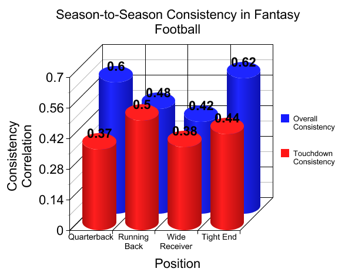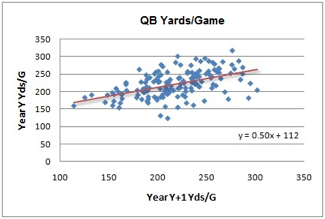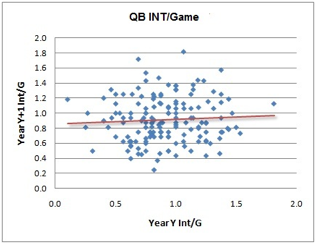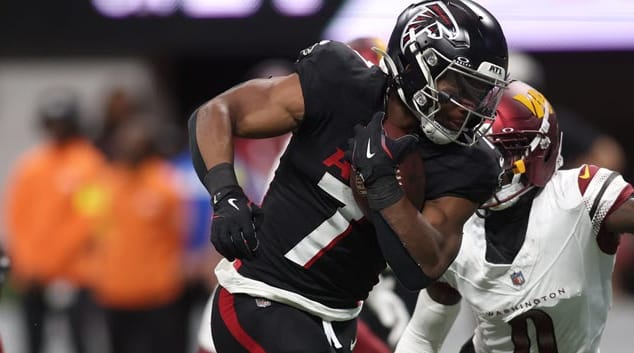In my inaugural post here at RotoWire, I discussed how consistency and volatility can and should shape your draft board. It's a topic that is fond to my heart (I'm strange), and if you're serious about your fantasy football, the same should be true of you. All summer, owners, analysts, and fantasy "experts" will work diligently to create accurate projections. They'll study statistical regression, schematic changes, and three-year trends in an effort to predict every last player's 2012 production down to the point. It's an important step in the process of formulating rankings.
But it isn't the only step. Year after year, 99 percent of fantasy owners forget (or don't know) that projections mean nothing without an understanding of consistency. That is, not only do you need to know how many points a player is most likely to score, but you need to know how likely he is to do so. Those players whose projected points possess a high standard deviation are said to be more volatile than those with a low standard deviation.
Volatility isn't necessarily a bad thing. Let's take a look at Joe Flacco, whose passing stats are as consistent as that of any player I've ever witnessed. Over the past three seasons, Flacco has thrown for 3,613 yards, 3,622 yards, and 3,610 yards. As Peter Griffin would say, "holy freakin' crap." Further, Flacco's touchdown totals have been 21, 25, and 20, and his interceptions have added up to 12, 10, and 12. When I
In my inaugural post here at RotoWire, I discussed how consistency and volatility can and should shape your draft board. It's a topic that is fond to my heart (I'm strange), and if you're serious about your fantasy football, the same should be true of you. All summer, owners, analysts, and fantasy "experts" will work diligently to create accurate projections. They'll study statistical regression, schematic changes, and three-year trends in an effort to predict every last player's 2012 production down to the point. It's an important step in the process of formulating rankings.
But it isn't the only step. Year after year, 99 percent of fantasy owners forget (or don't know) that projections mean nothing without an understanding of consistency. That is, not only do you need to know how many points a player is most likely to score, but you need to know how likely he is to do so. Those players whose projected points possess a high standard deviation are said to be more volatile than those with a low standard deviation.
Volatility isn't necessarily a bad thing. Let's take a look at Joe Flacco, whose passing stats are as consistent as that of any player I've ever witnessed. Over the past three seasons, Flacco has thrown for 3,613 yards, 3,622 yards, and 3,610 yards. As Peter Griffin would say, "holy freakin' crap." Further, Flacco's touchdown totals have been 21, 25, and 20, and his interceptions have added up to 12, 10, and 12. When I project Flacco for 3,600 passing yards, 22 touchdowns, and 11 interceptions in 2012, I can be pretty darn confident in that prediction.
In the stats world, Flacco's projected fantasy output has a very low standard deviation. Simulate 1,000 seasons, and chances are Flacco would come close to 3,600/22/11 more often than not. As a late-round pick, however, that isn't a good thing. When risk is low, we want to fill our rosters with guys whose play is more volatile, and thus possesses more upside. If our 14th-round pick is a bust, it doesn't have the same negative impact as missing in the first round.
In this way, you can see just how important it is to understand how consistency should shape your board. A solid understanding of volatility can be leveraged into a competitive advantage. In my book Fantasy Football for Smart People, I calculated the consistency of each position on a year-to-year basis.

Today, I'm going to take a closer look at the quarterback position. You can see above that quarterback is the second-most consistent position in fantasy football. The predictability of quarterback play, particularly the most elite passers in today's NFL, is the primary reason I'm a proponent of selecting a top-tier player at the position early in 2012 fantasy drafts.
By breaking down the quarterback position even further, we can get a sense of which stats are most consistent and should be weighted most heavily in projections. You can see above that passing touchdowns are actually the least consistent of all types of touchdowns. On average, 37 percent of passing touchdowns carry over each year, with the other 63 percent regressing toward a league mean. Passing yards, on the other hand, are much more predictable.

This idea matches up with common sense as well. With a huge sample size of pass attempts each season, quarterback passing yards tend to even out, i.e. it is relatively easy to project them. There is a much smaller sample size of passes on which a quarterback has a fairly high chance of throwing a touchdown (red zone passes, for example), and thus those totals are more susceptible to fluctuations from year to year.
For fantasy owners, this unpredictability should affect projections. It isn't that touchdowns don't matter; actually, they have more influence than any other stat. If accurately predicting them is a challenge, however, that difficulty should be reflected in the projections themselves. Taking an extreme example, imagine the range of quarterback touchdowns were zero through 100, but the season-to-season consistency of passing touchdowns is 0.0. In that case, passing touchdowns should be given zero weight in projections, despite the fact that they are highly influential in the outcome of your league.
In actuality, quarterback interceptions aren't too far off from that 0.0 correlation.

Interceptions are an incredibly fluky stat and regress strongly toward a league mean from year to year. There is some predictability with interceptions - we know Ryan Fitzpatrick will likely throw more than Aaron Rodgers in 2012 - but overall the stat is extremely volatile. You can still project interceptions as normal using past totals as a guide, but that projection shouldn't be weighted as heavily in your rankings as passing yards, for example.
The most consistent quarterback stats, by far, are rushing totals. In my next article, I'll discuss the consistency of quarterback rushing yards and touchdowns, detailing how to use them to your advantage (and showing why Cam Newton isn't nearly as risky a proposition as many believe).
Jonathan Bales is the author of Fantasy Football for Smart People: How to Dominate Your Draft. He also runs the "Running the Numbers" blog at DallasCowboys.com and writes for the New York Times.

























